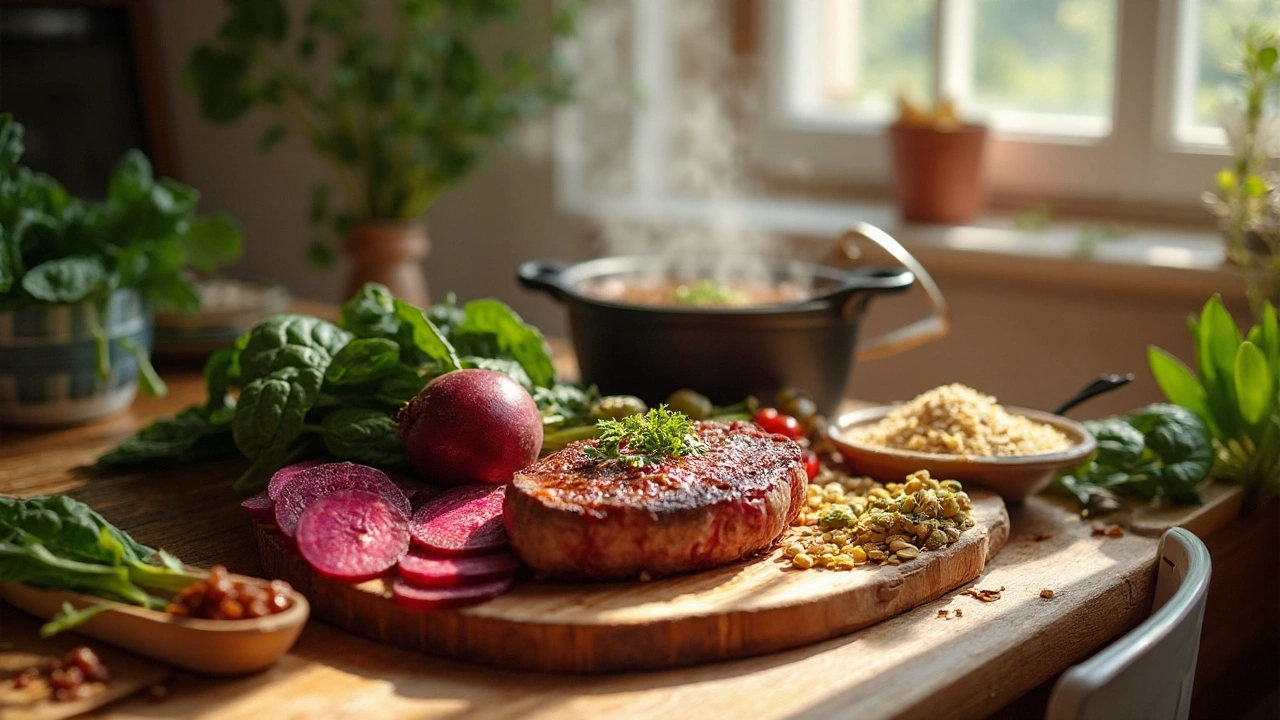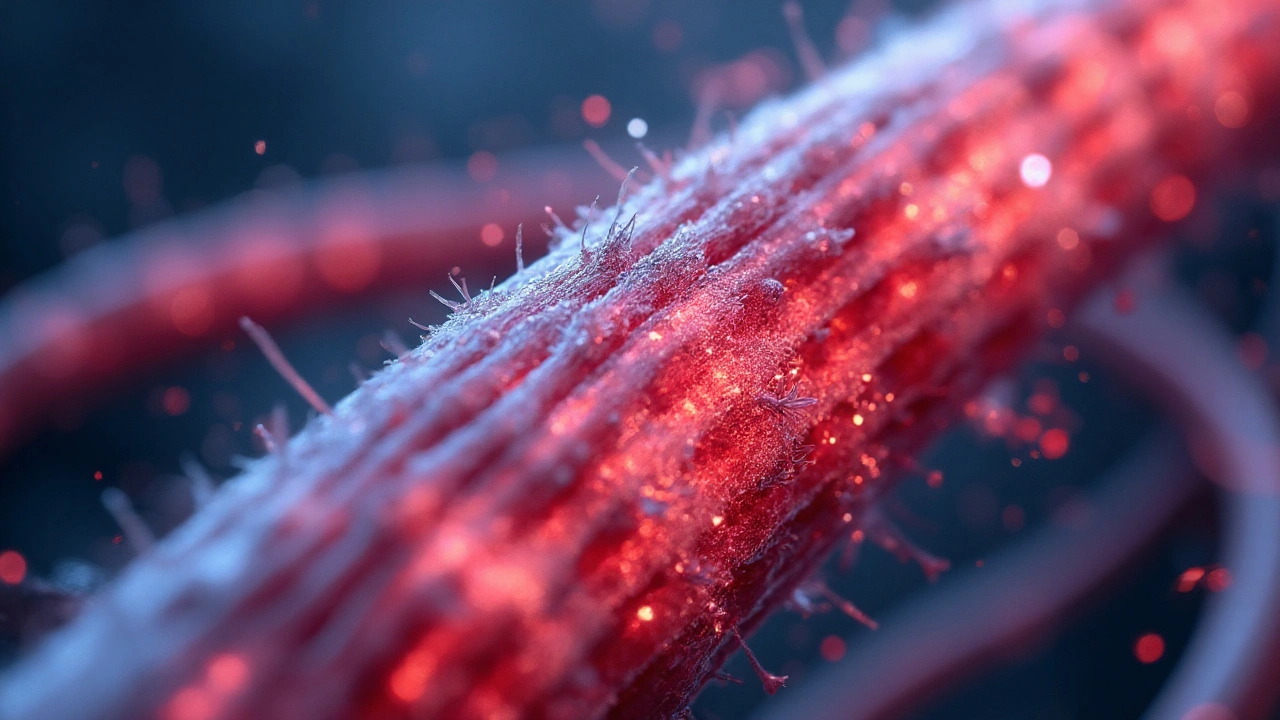Why Iron Matters for Muscle Health and Preventing Anemia
 Aug, 13 2025
Aug, 13 2025
When it comes to keeping your muscles firing and your blood flowing, iron tops the list of non‑negotiable nutrients. Iron is a trace mineral (atomic number 26) that plays a critical role in oxygen transport, energy metabolism, and muscle contraction. Low iron levels don’t just make you feel tired; they erode performance, weaken heart muscle, and set the stage for anemia. This article unpacks why iron matters for muscle function, how it shields you from anemia, and practical ways to keep your stores topped up.
How Iron Powers Muscle Contraction
Muscle fibers need a constant supply of adenosine triphosphate (ATP) to contract. Iron is a co‑factor for several enzymes in the mitochondrial electron‑transport chain, the powerhouse that turns oxygen and nutrients into ATP. Without enough iron, mitochondria slow down, and muscles fatigue faster.
Two iron‑rich proteins are directly tied to muscle performance:
- Hemoglobin is a protein in red blood cells that binds oxygen and delivers it to tissues, including working muscle.
- Myoglobin is a muscle‑specific oxygen‑binding protein that stores oxygen for rapid release during intense activity.
When hemoglobin levels dip, less oxygen reaches your muscles; when myoglobin is depleted, the muscle’s intracellular oxygen reservoir dries up, both resulting in reduced endurance and strength.
Iron’s Role in Preventing Anemia
Anemia isn’t a single disease; it’s a condition where blood can’t carry enough oxygen. Iron‑deficiency anemia, the most common form, arises when iron intake, absorption, or storage can’t meet the body’s demand.
The journey from dietary iron to red blood cells involves three key steps:
- Erythropoiesis is the process of producing new red blood cells in the bone marrow, heavily dependent on iron availability.
- Ferritin stores excess iron inside cells and releases it when needed, acting as the body’s iron bank.
- Transferrin is the blood‑borne transport protein that shuttles iron from the gut to the bone marrow and other tissues.
If any link in this chain breaks-say, low dietary iron, poor absorption, or chronic blood loss-fewer red cells are made, hemoglobin drops, and anemia sets in.
Types of Dietary Iron: Heme vs. Non‑Heme
Not all iron is created equal. The body absorbs heme iron (from animal sources) far more efficiently than non‑heme iron (from plants). Understanding the difference helps you choose foods that maximize uptake.
| Attribute | Heme Iron | Non‑Heme Iron |
|---|---|---|
| Typical Sources | Red meat, poultry, fish | Legumes, spinach, fortified cereals |
| Absorption Rate | 15‑35% (less affected by diet) | 2‑20% (highly influenced by enhancers/inhibitors) |
| Key Enhancers | None needed | VitaminC, meat factor, certain amino acids |
| Key Inhibitors | None significant | Phytates, calcium, polyphenols, coffee/tea |
For athletes and anyone chasing optimal muscle performance, pairing non‑heme iron foods with vitaminC (e.g., adding lemon juice to lentils) can boost absorption by up to 4‑fold.

Practical Strategies to Keep Iron Levels Optimal
Here’s a quick‑start checklist you can apply today:
- Include a source of heme iron in at least two meals per day-think beef strips, chicken thighs, or sardines.
- Combine non‑heme iron foods with vitaminC (citrus juice, bell peppers, strawberries).
- Avoid drinking coffee or tea with iron‑rich meals; the polyphenols bind iron and block uptake.
- Limit calcium supplements around iron‑rich meals; calcium competes for the same absorption pathways.
- Monitor ferritin levels annually if you’re an endurance athlete, pregnant, or have a history of heavy menstrual bleeding.
These steps address the three pillars of iron balance: intake, absorption, and storage.
Related Concepts and Next Steps
Understanding iron’s place in the body opens doors to deeper topics. You might also explore:
- Oxygen Transport - the physiological pathways that move oxygen from lungs to muscles.
- Energy Metabolism - how mitochondria convert nutrients into ATP, and why iron is a linchpin.
- Exercise Physiology - the impact of micronutrients on endurance, strength, and recovery.
- Nutrition for Women - special considerations for menstrual iron loss and pregnancy needs.
Each of these topics builds on the iron foundation, allowing you to fine‑tune health and performance.
Common Pitfalls and How to Avoid Them
Even well‑intentioned diets can sabotage iron status. Watch out for these traps:
- Vegetarian/vegan bias: Relying solely on non‑heme sources without vitaminC leads to hidden deficiencies.
- Excessive fiber: Whole‑grain breads are great, but too much can bind iron.
- Unnecessary supplements: High‑dose iron pills cause constipation and may interfere with zinc absorption.
- Ignoring symptoms: Fatigue, shortness of breath, and restless legs are early red flags; don’t wait for severe anemia.
Addressing these issues early keeps you on track for strong muscles and healthy blood.

Frequently Asked Questions
How much iron do adults need daily?
The Recommended Dietary Allowance (RDA) for iron is 8mg for adult men and 18mg for adult women of childbearing age. Post‑menopausal women and older men need about 8mg per day.
Can I get enough iron from a plant‑based diet?
Yes, but you must pair non‑heme iron foods (lentils, beans, tofu) with vitaminC sources (citrus, bell peppers) and limit inhibitors like coffee. Regular ferritin testing helps gauge effectiveness.
Why do athletes experience iron deficiency more often?
Intense training increases iron loss through sweat, hemolysis (broken red cells), and gastrointestinal bleeding. Additionally, high training volumes raise the demand for oxygen‑carrying capacity, putting extra pressure on iron stores.
Is iron supplementation safe?
Supplementation is safe when prescribed based on blood tests. Unchecked high‑dose iron can cause gastrointestinal distress, oxidative stress, and interfere with zinc and copper absorption. Always consult a healthcare professional before starting.
What foods are the best sources of heme iron?
Red meat (beef, lamb), poultry (especially dark meat), and fish (sardines, tuna) provide the most bioavailable heme iron. A 3‑oz serving of beef delivers about 2.1mg of iron, which the body absorbs at roughly 25‑30% efficiency.
Can vitaminC really boost iron absorption?
Yes. VitaminC reduces ferric iron (Fe³⁺) to the more soluble ferrous form (Fe²⁺), enhancing uptake in the duodenum. Studies show a 2‑fold increase when 50mg of vitaminC is consumed with a non‑heme iron meal.
dan koz
September 22, 2025 AT 20:03Been lifting for 8 years and never realized how much my fatigue was from low iron. Started eating liver once a week and my squat PR jumped 20lbs. No joke. Also stopped drinking tea after meals and my energy’s through the roof now. Thanks for the wake-up call.
Kevin Estrada
September 24, 2025 AT 19:08OMG I JUST REALIZED I’M A VEGAN AND I’M LITERALLY DRAINING MYSELF OF IRON LIKE A VAMPIRE IN A BAD HORROR MOVIE 😭
Bro I eat kale smoothies and quinoa bowls like it’s my job and now I’m weak as a kitten? This post just broke me. I’m going full carnivore. Send help. Or steak.
Katey Korzenietz
September 25, 2025 AT 19:12Ugh. So many people think ‘plant-based’ = automatically healthy. NO. You need heme iron. Period. My ferritin was 12 last year and I was dizzy climbing stairs. Took 3 months of beef + orange juice and now I’m fine. Stop listening to influencers who don’t know what transferrin is.
Ethan McIvor
September 26, 2025 AT 10:36It’s wild how something so small - a single atom, really - holds up our whole system. Iron’s like the quiet plumber behind the scenes, fixing leaks in our oxygen pipeline while we’re out running marathons or scrolling TikTok.
And yet we ignore it until we collapse. Maybe we need to stop treating our bodies like machines we only fix when they break. 🤔
Mindy Bilotta
September 26, 2025 AT 15:50For all you vegans out there - yes you CAN get enough iron, but it’s not magic. Add lemon to your lentil soup. Eat spinach with strawberries. Avoid tea with meals. And get your ferritin checked - not just hemoglobin. I’m a nurse and I see this all the time. You’re not broken, you just need to tweak your plate. 💪
Michael Bene
September 27, 2025 AT 20:16Look, I get it - iron’s important. But let’s not turn this into a cult. People are taking iron supplements like they’re gummy vitamins and then complaining about constipation and liver damage. And don’t even get me started on the ‘drink orange juice with your kale’ trend. It’s not 2012 anymore, Karen.
Real talk? If you’re tired, sleep more. Move more. Eat real food. Stop chasing micronutrient fairy dust. Iron’s not the magic bullet - it’s one piece of a giant, messy, beautiful puzzle. And if you’re still tired after eating meat and citrus? Go see a doctor. Not Reddit.